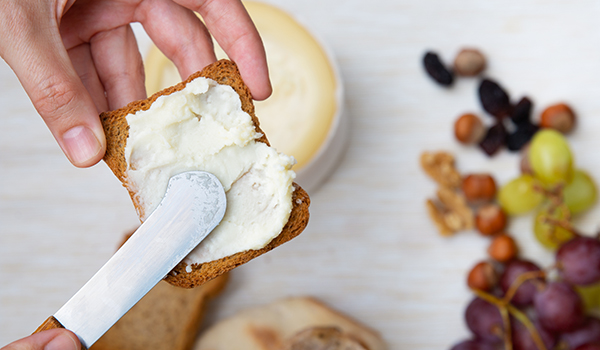Nutritionists offer advice on how to include butter in a diabetic meal plan.
Statistics from the Centers for Disease Control and Prevention show that nearly 37.3 million Americans (or 11.3% of the U.S. population) have diabetes. You may have wondered what foods you can (and perhaps cannot) eat when adhering to a diabetes-friendly diet, butter included, whether you have the disease yourself or someone you know is experiencing it.
You can relax knowing that this article has you covered. We’ve spoken with certified diabetes educators and registered dietitians to get the lowdown on what you should know about consuming fats like butter in your diet.
How Dietary Fats Affect People with Diabetes
You might recall the time when everything was ultra-low-fat. Fortunately, since then, research has advanced significantly and demonstrated how certain types of fat can truly benefit illnesses like diabetes. Here, “right fats” is crucial.
To refresh your memory, the three primary forms of fats in the diet are trans, saturated, and unsaturated fatty acids. Saturated and unsaturated fats are both present in the typical American diet, but trans fats have been outlawed because of their detrimental health effects. To put it simply, unsaturated fats have been found to have more heart-healthy and anti-inflammatory properties, while saturated fats are advised to be limited in diets. You can read more about the differences between these two types of fats in our article.
Saturated fats are typically found in animal products and are solid at room temperature. The 2020-2025 Dietary Guidelines for Americans recommends limiting your intakes of saturated fats to no more than 10% of your daily caloric value, or around 20 grams per day based on a 2,000-calorie diet. Conversely, unsaturated fats, such as mono- and polyunsaturated fatty acids, are liquid at room temperature and are mostly present in nuts, seeds, fatty fish, and oils like canola and olive. At least twice a week, one should consume certain unsaturated fats, such as omega-3 fatty acids, preferably from seafood.
Now, how exactly do these fat types affect someone with diabetes?
Dietitian Erin Palinski-Wade, RD, CDCES, of New Jersey and author of the 2-Day Diabetes Diet, states that diets high in saturated fat are linked to an increased risk of heart disease and stroke, two conditions that are frequently co-occurring with diabetes. It is a fact that individuals with diabetes are twice as likely to develop heart disease as people without the condition. Furthermore, she reveals, “Iliposis is another condition that can be brought on by saturated fats and makes it harder to maintain normal blood sugar levels.”
Conversely, Palinski-Wade reminds us that studies have demonstrated the beneficial effects of mono- and polyunsaturated fats on the management of diabetes, as well as their potential to enhance insulin sensitivity and heart health. This view is backed by a 2019 study that was published in the British Medical Journal. It discovered that individuals with type 2 diabetes who consumed more polyunsaturated fats than carbohydrates or saturated fats did not have a higher risk of dying from cardiovascular disease or total mortality.
The main idea is that, whether or not you have been diagnosed with diabetes, you should be mindful of the kind of fat you eat.
Can You Eat ButterIf You Have Diabetes?
Yes, even if you have diabetes, all foods are acceptable according to nutrition experts. “Like everything in life, enjoying foods like butter in moderation is key to maintaining balance and reaching optimal nutrition, health, and wellness,” says dietitian and co-founder of MIJA Sarah Koszyk, M.A., RDN.
Palinski-Wade and Koszyk both point out that butter contains 7 grams of saturated fat for every tablespoon serving. Many health organizations advise limiting your intake of this nutrient, so they advise you to take their advice and use butter in moderation.
If you like the flavor of butter, think about using it sparingly—a pat or one-teaspoon portion—where you can truly taste the flavor profile of the ingredient rather than using it as your go-to cooking fat.
Advice for Including Butter in a Healthful, Diabetes-Friendly Diet
Even though you might have clear memories of your grandmother adding a stick—or two—of butter to her mashed potatoes, experts—including chefs—want to remind you that, when it comes to flavor enhancers like butter, a little really does go a long way.
Consider these tips Koszyk and Palinski-Wade recommend to help maximize the flavor of your favorite butter brand while keeping your portions in check:
Drizzle a steamed vegetable such as broccoli, cauliflower, asparagus, or zucchini with one teaspoon of butter. To add more flavor to the vegetables, add some herbs and spices. (Think about preparing one of these ten veggies that are best for diabetics.)
While scraping off the hearty base of the petal, melt 1 teaspoon of butter and dip a steamed or boiled artichoke into it.
For added flavor, sauté mushrooms in a teaspoon of butter and serve over roasted chicken or grilled or roasted fish.
If you make baked goods, think about replacing butter with a vegan alternative such as avocado, applesauce, or coconut oil, or even half butter and half vegan alternative.

